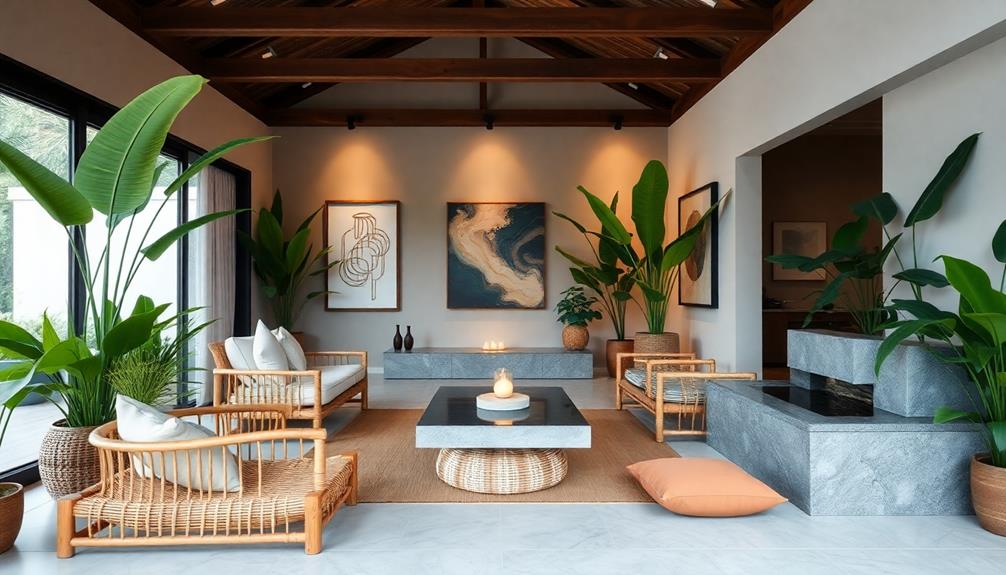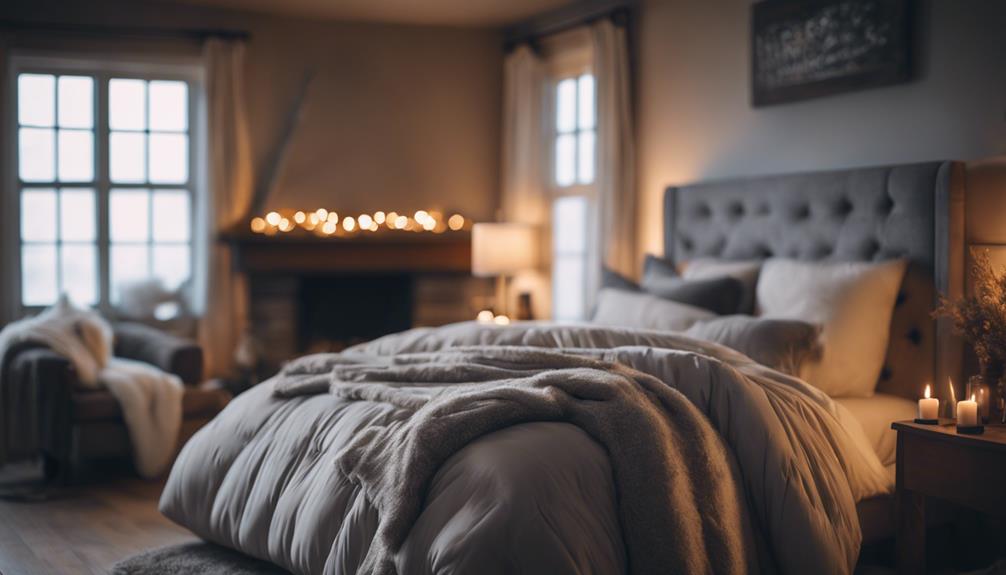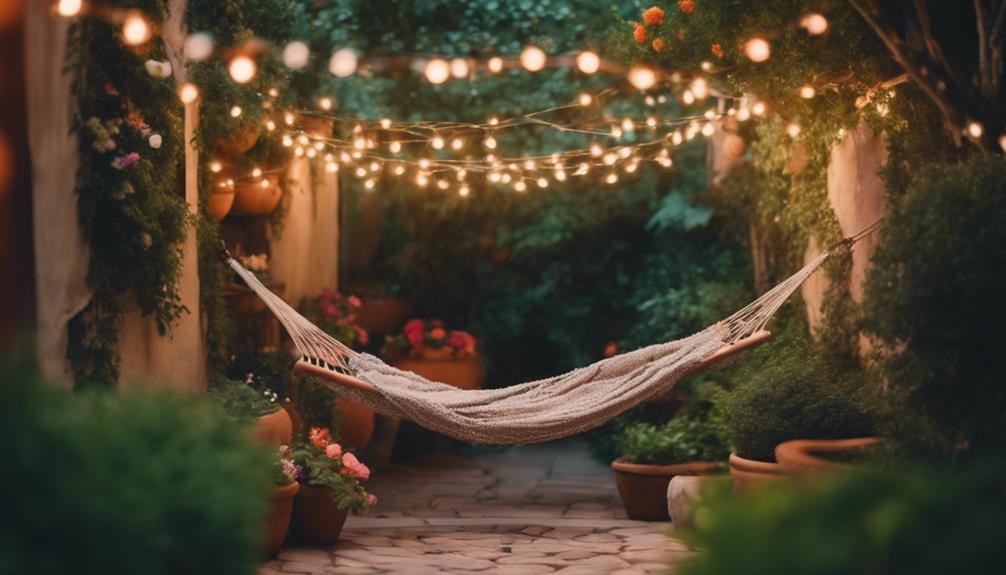Bringing Bali home means blending natural elements with modern sophistication. Use organic materials like wood and stone to achieve that serene vibe. Open floor plans enhance airflow and light, creating spaciousness. Don't forget earthy colors—think greens and browns for a soothing backdrop. Incorporate tropical plants and statement pieces for a chic touch. By mixing casual elegance with tropical inspiration, you can create a tranquil retreat that feels grounded yet stylish. Whether it's adding water features or local textiles, there's so much to explore to perfect your Bali-inspired oasis at home. You'll discover more ways to enhance your space.
Key Takeaways
- Incorporate natural materials like wood and bamboo to create a serene and organic feel reminiscent of Bali's aesthetics.
- Utilize open floor plans and large windows to enhance airflow and natural light, fostering a tranquil atmosphere.
- Choose an earthy color palette with browns, greens, and neutrals to evoke a calming and soothing environment.
- Add statement furniture pieces and traditional Indonesian decor to blend modern chic with Bali's cultural artistry.
- Integrate water features and tropical plants for a refreshing ambiance that reflects the essence of tropical living.
Embracing Bali's Natural Aesthetics
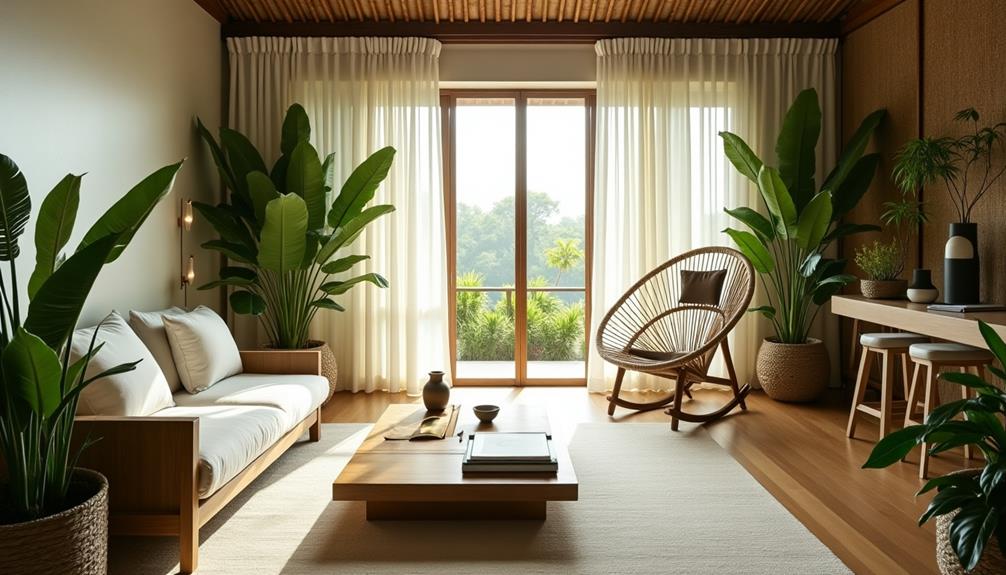
When you embrace Bali's natural aesthetics, you're inviting a sense of tranquility into your home. This style of interior design prominently features organic materials like wood, bamboo, stone, and rattan, fostering a harmonious connection with the environment.
Balinese design characteristics emphasize traditional craftsmanship and sustainability, enhancing the overall appeal of your space. By using these materials, you create spaces that feel grounded and serene.
Open floor plans are essential in this design approach, allowing airflow and natural light to flow seamlessly throughout your living areas. This promotes a calming atmosphere that encourages relaxation and peace.
Earthy color palettes—think browns, greens, and neutrals—echo the lush landscapes of Bali, adding to the overall sense of calm.
You can further enhance your space by incorporating indoor-outdoor living areas, which blur the lines between interior and nature. This connection brings the beauty of the outdoors inside, elevating your experience of serenity.
Don't forget to add tropical plants and greenery as decor elements; they not only beautify your space but also cultivate a zen-like environment, integral to Balinese living.
Key Elements of Modern Chic Design
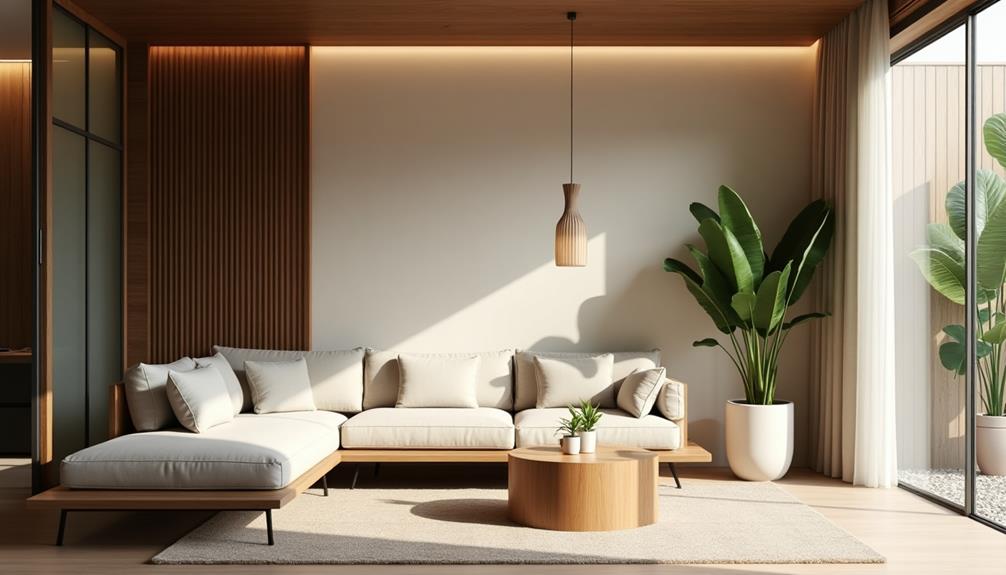
Modern chic design combines elegance with simplicity, creating spaces that feel both sophisticated and inviting. This style focuses on a few key elements that can transform your home into a modern sanctuary. Incorporating elements of traditional Indonesian style home decor can further enhance the warmth and character of your space.
- Clean Lines and Neutral Palette: Emphasize simplicity with clean lines and a neutral color palette, using bold colors as accents to add personality and vibrance to your space.
- Textures and Materials: Mix and match materials like wood, metal, and glass. This combination not only adds depth but also brings a tactile quality that makes your space feel warm and inviting.
- Open Floor Plans: Embrace open floor plans that encourage natural light and airflow. This creates a sense of spaciousness and a connection with the outdoors, enhancing your overall well-being.
- Statement Furniture Pieces: Invest in statement furniture like sculptural chairs and minimalist coffee tables. These pieces serve as focal points, enhancing the aesthetic while ensuring functionality throughout your home.
Transforming Spaces With Tropical Inspiration

Bringing tropical inspiration into your home can elevate your design aesthetic, creating a serene retreat that feels both invigorating and vibrant.
Start by incorporating natural materials like wood, bamboo, and stone, which are essential components in luxury tropical design aesthetics. These elements evoke the essence of tropical living, creating a warm and inviting atmosphere.
Utilize open floor plans to enhance airflow and natural light, promoting a seamless indoor-outdoor connection that's essential to Bali-style design.
Embrace earthy color palettes featuring browns, greens, and neutrals, which evoke a sense of tranquility and harmony reminiscent of Bali's lush landscapes.
To introduce a calming element, enhance your space with water features like small indoor fountains or ponds.
These additions reflect the serene ambiance of Bali and make your home feel more connected to nature.
Creating a Tranquil Retreat at Home
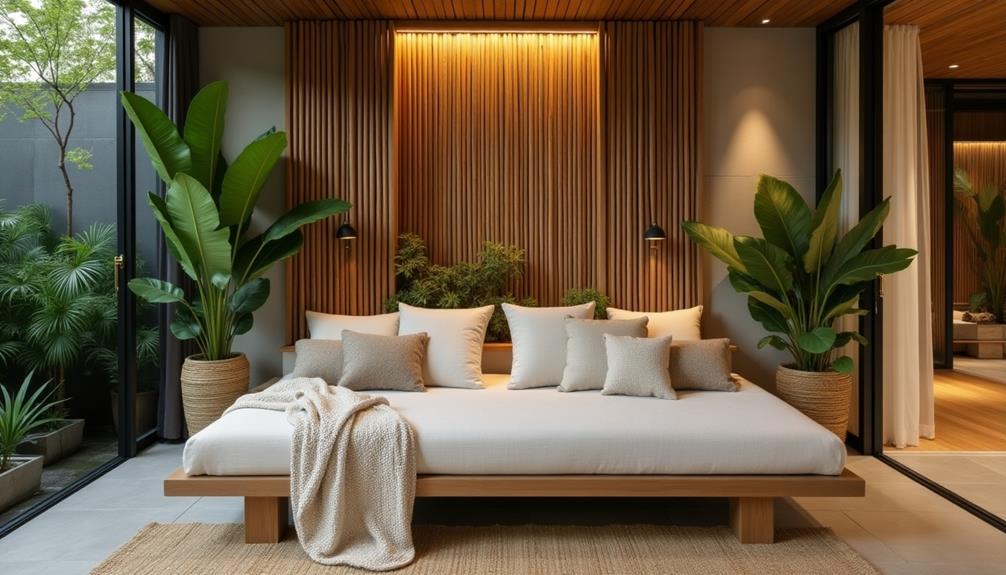
Creating a tranquil retreat at home starts with infusing your space with elements that promote relaxation and harmony. You can transform your living area into a serene oasis by focusing on natural materials, colors, and features that echo the beauty of Bali. Incorporating Indonesian decorative pillows with vibrant colors and intricate patterns can enhance comfort while reflecting cultural heritage.
- Natural Materials: Incorporate wood, bamboo, and stone into your design. These elements connect you to nature, fostering a calming environment.
- Open Spaces: Utilize an open floor plan and large windows to maximize natural light and airflow. This design invites the outside in, creating an inviting atmosphere reminiscent of Bali's seamless indoor-outdoor living.
- Earthy Palette: Choose shades of browns, greens, and neutrals for your color scheme. These soothing tones set a tranquil backdrop, encouraging relaxation in every corner of your home.
- Water Features: Add small fountains or indoor plants. These elements enhance your space's ambiance, echoing Balinese aesthetics and promoting a sense of peace.
Curating Your Bali-Inspired Decor
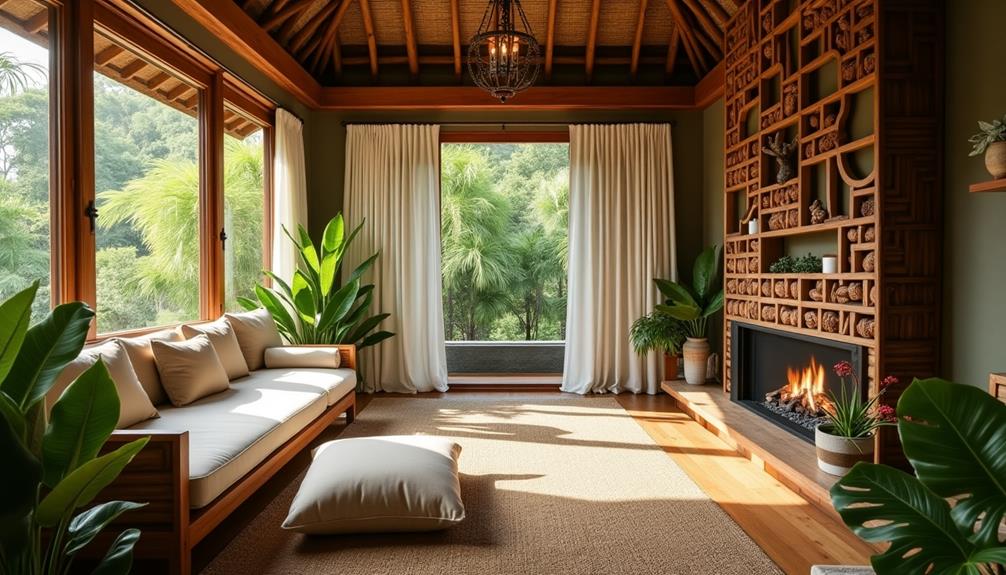
Curating your Bali-inspired decor means selecting pieces that embody the island's vibrant culture and natural beauty. Start by incorporating natural materials like wood, bamboo, and stone. These elements create a warm atmosphere reminiscent of Bali's traditional architecture.
You can also enhance your space with traditional artistry by including Indonesian decor masks, which serve as unique decorative pieces. Aim for an open floor plan and large windows to maximize natural light and promote airflow, fostering a seamless connection between your indoor and outdoor spaces.
Next, choose an earthy color palette with shades of browns, greens, and neutrals to evoke the tranquil vibes of Bali's lush landscapes. These colors will create a soothing backdrop for your decor.
Infuse warmth and texture by adding local textiles, such as batik fabrics and woven rugs, celebrating Balinese craftsmanship.
Don't forget to integrate decorative elements like handcrafted sculptures, tropical plants, and water features, which enhance the serene ambiance characteristic of Bali-style interiors.
These details will invite a sense of peace and relaxation into your home. By thoughtfully selecting these elements, you'll transform your space into a sanctuary that reflects the essence of Bali, allowing you to enjoy a slice of paradise every day.
Frequently Asked Questions
What Colors Are Best for a Bali-Inspired Home?
To create a Bali-inspired home, focus on earthy tones like warm browns, soft greens, and soothing blues. These colors evoke nature's tranquility, helping you feel relaxed and connected to the serene beauty of Bali's landscapes.
How Can I Incorporate Bali Decor on a Budget?
Did you know that 60% of people find thrifted decor more appealing? You can incorporate Bali decor on a budget by visiting thrift stores, crafting DIY projects, and using natural materials like bamboo and rattan.
What Types of Plants Thrive in Indoor Settings?
To create a vibrant indoor space, you'll love low-maintenance plants like snake plants, pothos, and peace lilies. They thrive in various light conditions and improve air quality, adding life and freshness to your home.
Are There Specific Materials to Avoid for a Bali Look?
Avoid heavy metals and synthetic materials that clash with Bali's natural vibe. Instead, embrace light bamboo and soft cotton, letting the sun filter through sheer fabrics, creating a serene, airy atmosphere that invites tranquility.
How Do I Maintain a Balanced Aesthetic With Modern Furniture?
To maintain a balanced aesthetic with modern furniture, mix textures and colors. Incorporate natural elements like wood or stone, and choose pieces that complement each other. Don't overcrowd; let each item breathe and shine.
Conclusion
By blending Bali's natural aesthetics with modern chic design, you can turn your home into a personal paradise. Picture yourself lounging in a serene space that feels like a luxury resort, without having to hop on a plane. Incorporate tropical elements and curate decor that sparks joy, making every day feel like a vacation. So, grab your favorite book and a coconut drink, and let the tranquil vibes of Bali wash over your home sweet home.
